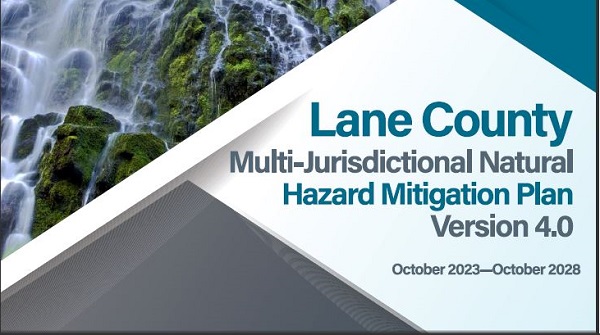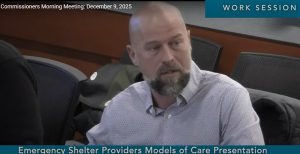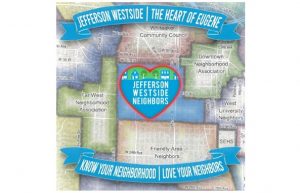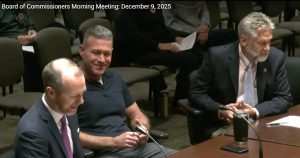County consolidates natural hazard mitigation plans; survey open through Sept. 22
5 min read
|
Getting your Trinity Audio player ready...
|
from City of Eugene Public Works and staff reports
As the chief of Eugene Springfield Fire said at the time of the Holiday Farm Fire: “This is the wake-up call.“
Local response to the Labor Day wildfires and to the COVID-19 pandemic highlighted the need among regional jurisdictions for more collaborative and integrated processes for preparedness, mitigation, response, and recovery.
Now the cities of Eugene and Springfield and the utilities EWEB and Rainbow Water are preparing to fold their Multi-Jurisdictional Natural Hazards Mitigation Plan (MJNHMP) into the Lane County plan as annexes. Combining many plans into one countywide plan allows for more efficient management; it helps with risk planning as well as better coordination among area partners.
The four agencies will host two public sessions about transitioning to the county plan, renewing their own annex plans, and providing updates about their planning efforts. The public is encouraged to attend the sessions to learn more and to share feedback:
- Wednesday, Sept. 4, 2024, 6 – 7:30 p.m., Eugene Springfield Fire, 1705 W Second Ave., Classroom 1
- Tuesday, Sept. 10, 2024, 5:30 – 7 p.m., Springfield City Hall, 225 Fifth St., Jesse Maine Room
No registration is required. The two sessions are free and open to the public.
A natural hazards mitigation plan identifies natural hazards, vulnerabilities and risks facing local governments; it prioritizes processes and actions to reduce the risks. The public information sessions will cover:
- Natural Hazard Mitigation Plan overview
- Local natural hazards
- Mitigation planning efforts
- Transition to county plan coordination
- Wildfire risk reduction
- Resources for homeowners
The public is also invited to participate in a public feedback survey on natural hazard mitigation planning efforts, through Sept. 22. Results will help agencies in the planning process. A report on the results will be included in the natural hazard mitigation annex plans.
Eugene and EWEB are planning, among others, the following mitigation actions:
- Develop a database of unreinforced masonry buildings (URMs) for first responders to utilized for planning and response operations. Areas include Eugene, Springfield, and parts of Lane County (Eugene Springfield Fire’s response area).
- Evaluate off-street path bridges crossing over the Willamette River to complete a high-level seismic assessment of all major city bridges.
- Pursue a water reuse partnership with MWMC. The Metropolitan Wastewater Management Commission (MWMC) will add facilities to the wastewater treatment plant to produce the first-ever stream of Class A recycled water – the highest quality recycled water class in Oregon, suitable for all water uses except drinking.
- Complete seismic improvements to Chambers Bridge over UPRR and Bailey Hill Road at Amazon Creek, and to West 11th Bridge at Amazon Creek.
- Second source project. Construct a new water intake structure and filtration plant on the Willamette River, with necessary water transmission lines, to provide a secondary source of drinking water supply, treatment and delivery.
- Rebuild College Hill water reservoir. Once the new tanks at College Hill are complete, the Santa Clara Reservoir, classified as a high hazard dam, can be taken offline.
- Grid hardening. Improve early detection, response and resiliency to wildfires and other severe weather events with enhanced vegetation management practices, advanced technology and fire-resistant equipment.
Another highlight of the city of Eugene’s annex is a review of historic significant natural events in Eugene:
| Event Type | FEMA #* | Year | Timeframe | Damage Amt.** | Additional Event Information |
|---|---|---|---|---|---|
| Extreme Heat | 2024 | JUL 3–8 | >100°+ Consecutive Days – 4 | ||
| Severe Winter Storm | DR-4768- OR | 2024 | JAN 12-27 | $1.6M | 4+ inches of ice in Eugene; Lane Co. Estimated Damage = $35M |
| Extreme Heat | 2023 | AUG 13-16 | >100°+ Consecutive Days – 4 | ||
| Wildfire Smoke(1) | 2023 | MAY – SEPT | 15 days of air quality unhealthy for sensitive groups or worse. | ||
| Wildfire Smoke(1) | 2022 | MAY – SEPT | 6 days of air quality unhealthy for sensitive groups or worse. | ||
| Extreme Heat | 2021 | JUN 27 | 111° – Highest Temp Ever Recorded for COE | ||
| Wildfire Smoke(1) | 2021 | MAY – SEPT | 14 days of air quality unhealthy for sensitive groups or worse | ||
| Drought | 2020 | Near record breaking dry spell | |||
| Wildfire Smoke(1) | 2020 | MAY – SEPT | 14 days of air quality unhealthy for sensitive groups or worse. | ||
| Wildfire/Straight Line Wind Event | DR-4562-OR | 2020 | SEPT 8-14 | 2020 Labor Day Fires and Straight-line winds | |
| Flooding | 2019 | 2019 Flooding, middle fork of the Willamette – exceed 1996 flow levels | |||
| Severe Winter Storm | DR-4432-OR | 2019 | FEB 25-MAR 1 | Heavy Snow – 9-12in | |
| Wildfire Smoke(1) | 2019 | MAY – SEPT | 5 days of air quality unhealthy for sensitive groups or worse. | ||
| Wildfire Smoke(1) | 2018 | MAY – SEPT | 22 days of air quality unhealthy for sensitive groups or worse. | ||
| Wildfire Smoke(1) | 2017 | MAY – SEPT | 16 days of air quality unhealthy for sensitive groups or worse | ||
| Severe Winter Storm | DR-4269-OR | 2016 | DEC 15-22 | $1.6M | Ice Storm – 20,000 power outages |
| Windstorm | 2016 | JAN 16 | $15,000 | Peak gusts up to 63 mph | |
| Extreme Heat | 2015 | JUL 29-AUG 1 | >100°+ Consecutive Days | ||
| Wildfire Smoke(1) | 2015 | MAY – SEPT | 3 days of air quality unhealthy for sensitive groups or worse. | ||
| Windstorm | 2015 | DEC 10 | $260,000 | Peak gusts up to 47 mph, widespread power outages | |
| Severe Winter Storm | DR-4169-OR | 2014 | FEB 6-24 | $1.7M | Heavy Snow/Freezing Rain – 0.75 inches of ice, 10,000 power outages |
| Wildfire Smoke(1) | 2014 | MAY – SEPT | 1 days of air quality unhealthy for sensitive groups or worse. | ||
| Extreme Cold | 2013 | DEC 7-11 | < 10° Consecutive Days - 5 | ||
| Extreme Cold | 2013 | DEC 7-9 | < 0° Consecutive Days - 3 | ||
| Severe Winter Storm | 2013 | Jan 10 | Freezing Temps, de-icing incident | ||
| Severe Winter Storm | 2013 | DEC 4-13 | Heavy Snow/Extreme Cold – 8-9in | ||
| Wildfire Smoke(1) | 2013 | MAY – SEPT | 10 days of air quality unhealthy for sensitive groups or worse. | ||
| Severe Winter Storm | 2012 | MAR 21-26 | $317,612 | ||
| Severe Winter Storm | DR-4055- OR | 2012 | JAN 17-21 | Snow/Ice – 2,000 power outages | |
| Windstorm | 2011 | MAR 13 -16 | |||
| Severe Winter Storm | 2010 | DEC 27-29 | Ice Incident | ||
| Severe Winter Storm | 2010 | NOV 23-24 | Heavy Snow | ||
| Extreme Heat | 2009 | JUL 27-29 | >100°+ Consecutive Days | ||
| Extreme Heat | 2009 | JUL 28 | 106° | ||
| Severe Winter Storm | 2008 | DEC 27-29 | Heavy Snow/Ice Incident | ||
| Extreme Heat | 2006 | JUL 22-24 | >100°+ Consecutive Days | ||
| Windstorm | 2006 | FEB 3-4 | $300,000 | Peak gusts of 46 mph, 3500 without power in County | |
| Windstorm | 2006 | MAY | $5,000 | 13,000 without power | |
| Windstorm | DR-1405- DR | 2002 | FEB 7-8 | $6M | Peak gusts up to 70 mph |
| Windstorm | 2001 | MAR 13 | Peak gusts of 60 mph, 25,000 power outages in County, trees toppled, and buildings damaged | ||
| Severe Winter Storm | 1998 | DEC-FEB | Heavy Snow – one of the snowiest winters in Oregon history | ||
| 1996 Floods | 1160,1149,1099 | 1996 | FEB, NOV, DEC | Severe storms and flooding | |
| Windstorm | 1107-DR- OR | 1995 | DEC | Peak gusts up to 49 mph, 62 mph in Willamette Valley; saturated soils compounded damage | |
| Severe Winter Storm | 1993 | FEB 18-19 | Heavy Snow – 6 to 12 in | ||
| Severe Winter Storm | 1992 | DEC 16-17 | Heavy Snow | ||
| Severe Winter Storm | 1990 | FEB 11-16 | Heavy Snow – Avg. 8 in | ||
| Extreme Cold | 1989 | FEB 2-9 | < 20° Consecutive Days - 8 | ||
| Extreme Cold | 1989 | FEB 3-8 | < 10° Consecutive Days - 6 | ||
| Extreme Heat Event | 1981 | AUG 7-10 | >100°+ Consecutive Days, 108° | ||
| Extreme Cold | 1972 | DEC 8 | -12° | ||
| Extreme Cold | 1972 | DEC 4-14 | < 20° Consecutive Days - 11 | ||
| Extreme Cold | 1972 | DEC 7-11 | < 0° Consecutive Days - 5 | ||
| Snow | 1969 | January | Largest recorded snow accumulation 47.1 in | ||
| Flood | 184 | 1964 | DEC | Largest recorded flood in City/County history | |
| Severe Windstorm | 136 | 1962 | OCT 12-16 | Wind Gusts 86mph | |
| Windstorm | 1961 | JAN 7-8 | Highest Sustained Wind – 58mph/Gust – 78mph | ||
| Extreme Cold | 1950 | FEB 2-3 | < 0° Consecutive Days - 2 | ||
| Extreme Cold | 1924 | DEC 17-27 | < 20° Consecutive Days - 11 | ||
| Extreme Cold | 1924 | DEC 23-25 | < 0° Consecutive Days – 3 |
Sources for the historical record of significant natural events:
- City of Eugene – Public Works
- National Weather Service – NWS-Climate Book
- FEMA – Assigned Federally Declared Disaster Number
- (1) Oregon Department of Environmental Quality – Air Quality Trends Report
For more information about natural hazard mitigation plans, see:
- Lane County Natural Hazard Mitigation Plan
- City of Eugene Natural Hazards Mitigation Plan
- EWEB Natural Hazard Mitigation Plan
- Springfield Natural Hazard Mitigation Plan
- Rainbow Water District Natural Hazards Mitigation Plan
- State of Oregon Natural Hazard Mitigation Plan
- State of Oregon Geo Hazard View – HAZVU
- FEMA Risk Mitigation Planning for Homeowners/Business Owners
- Oregon Wildfire Response and Recovery
These emergency management documents are also searchable at the Whole Community News document repository.



